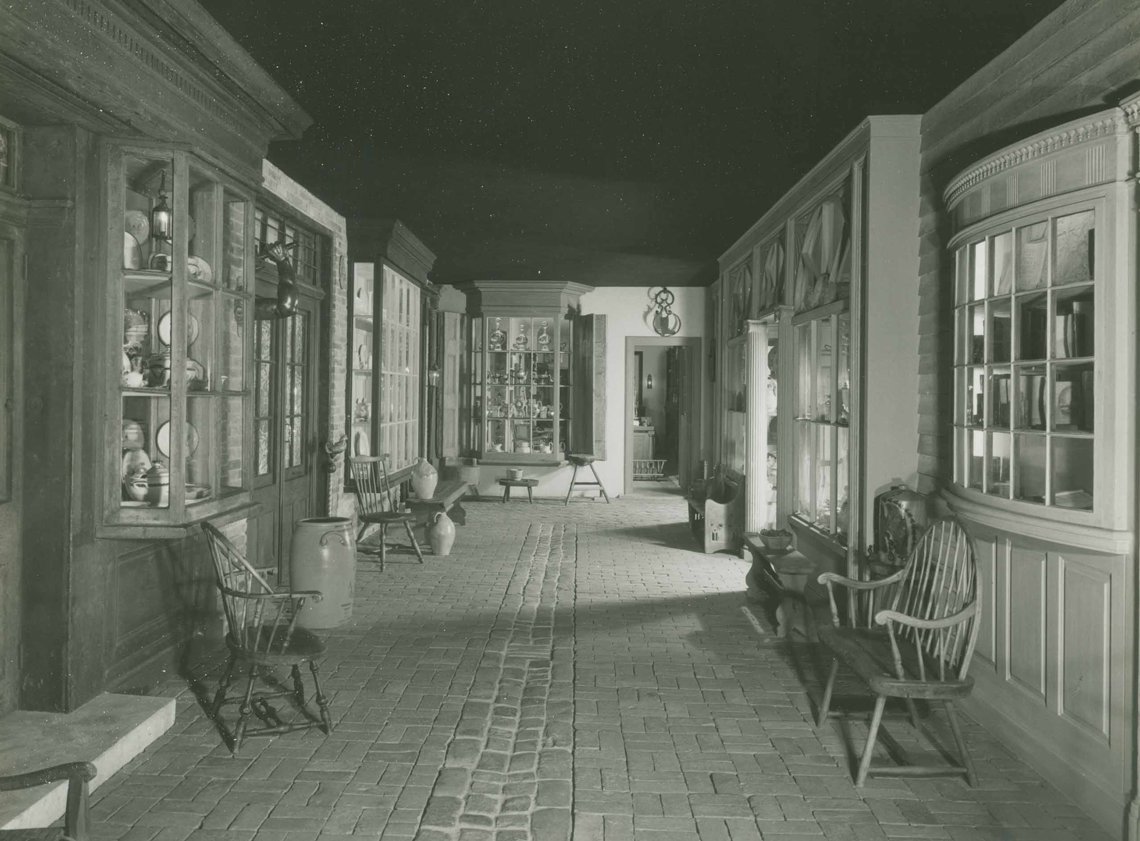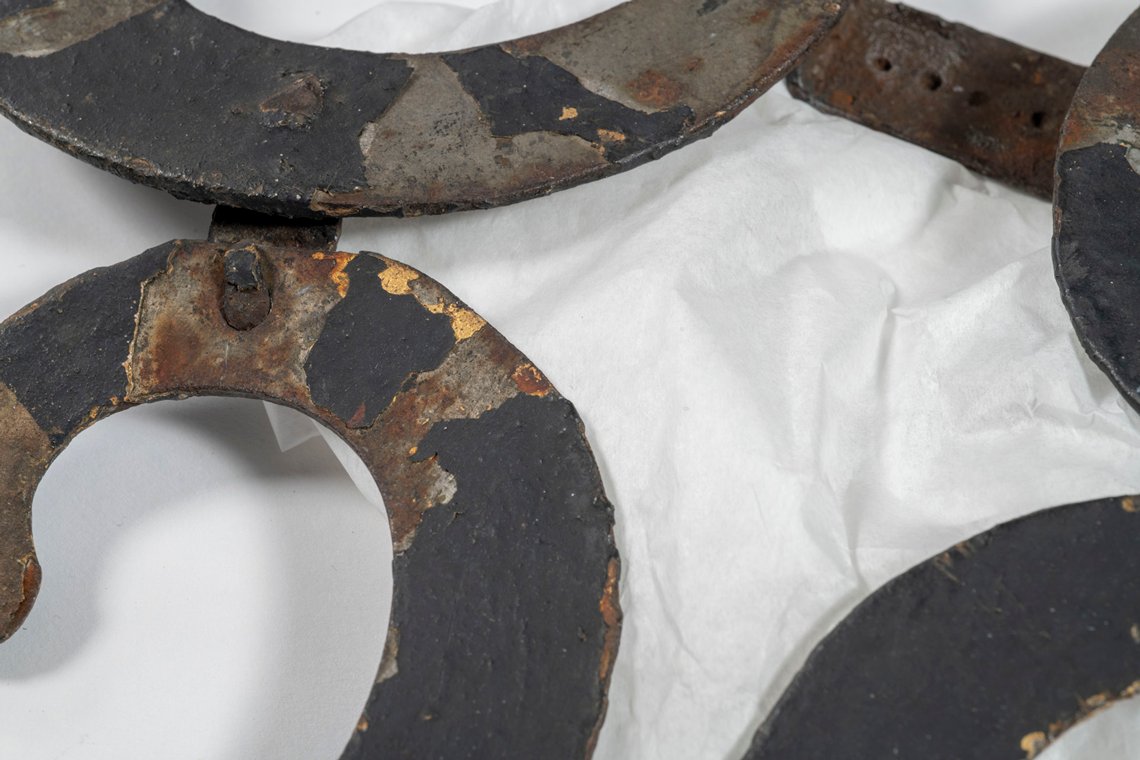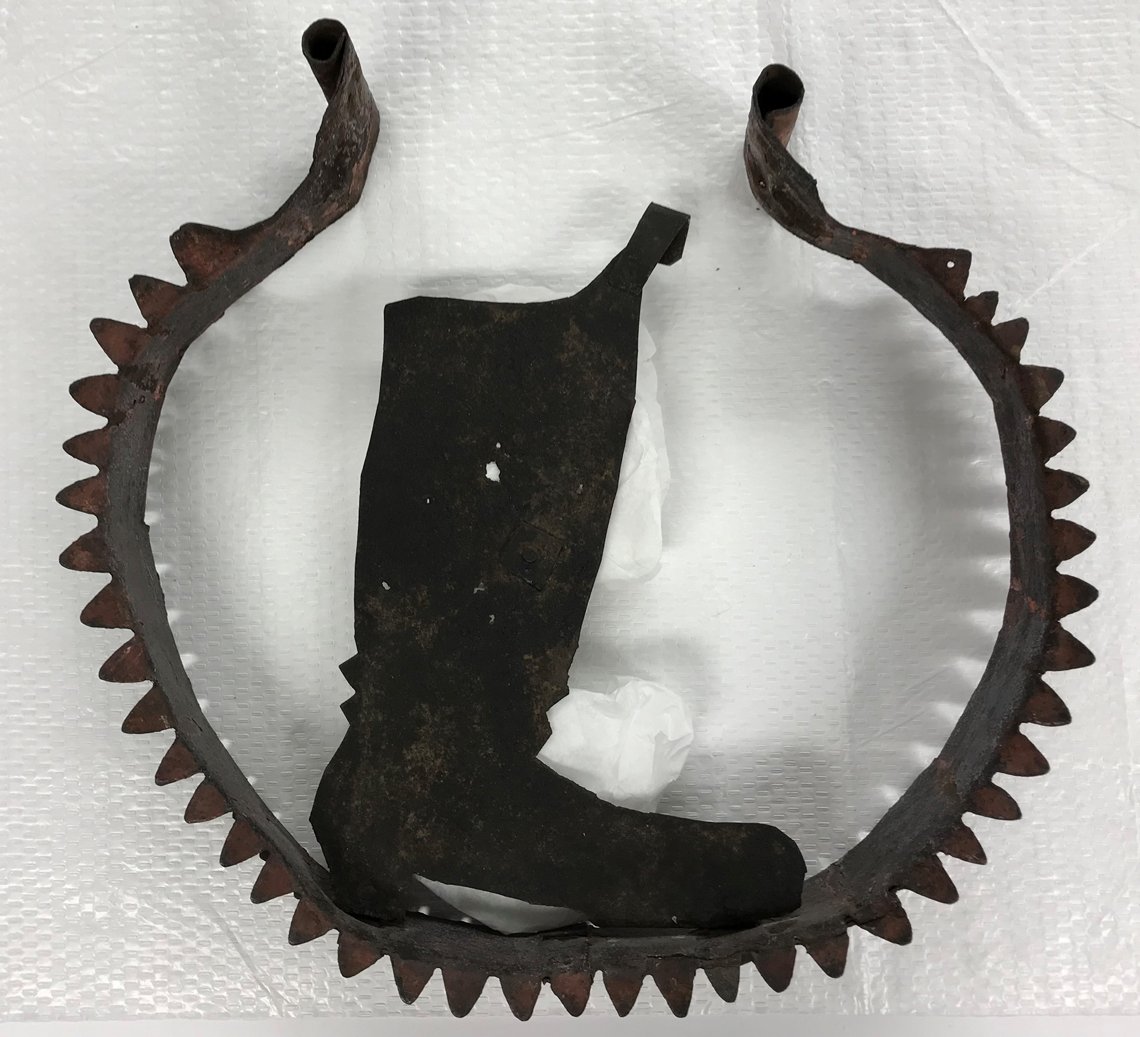Anonymous by Trade, Identified by Sight: Exploring a Shop Sign at Winterthur
Some of the most interesting objects in any collection are those with no provenance or known history. An object’s hidden history can be found in every scratch, repair, eroded surface, paint layer, material, and form. Meaning can be applied to objects in different ways based on the context in which they are staged. This shoemaker trade sign may have served other purposes. For instance, the sign could have hung outside a tavern, beckoning in strangers as candlelight flickered onto its gilded surface. Undoubtedly it meant economic stability to the antique dealer who sold it to Henry Francis du Pont before 1952. Today the shoemaker’s trade sign hangs above a doorway in Winterthur Museum’s Shop Lane, adding a bit of realism to a curated alleyway where the objects are real, but their interplay is a choreographed dance bound to early 20th-century colonial revival ideals (fig. 1).
The sign undoubtedly had a colorful history. At almost 200 years old and featuring various paint campaigns on each surface, the trade sign experienced multiple surface treatments due to corrosion, changing tastes, or changing hands. Repainting allowed the shop owner to exhibit their fashionable taste to the public. It likely acted as a way finder for weary travelers and potential customers. We know little about the sign aside from what it looks like, but the object treatment analysis performed by the Winterthur conservation team has revealed its material history through layers of paint and rust, unveiling the ways in which this sign was used over its lifetime (fig. 2). The boot motif, the type of paint chosen to decorate its surface, and the small holes and exposed metal reveal a long, arduous life. The surface and iconography can reveal the social and material life of 18th- and 19th-century trade and tavern culture.
 |
| Fig. 1. Shop Lane, Winterthur Museum, ca. 1952. Winterthur Archives. Photo by Samuel H. Gottscho.In this photo taken not long after the museum first opened, the trade sign can be seen hanging over the door at the rear, where it still hangs today. |
 |
| Fig. 2. Shoemaker shop sign, United States, 1790–1825. Iron, sheet iron, paint, gilding. Bequest of Henry Francis du Pont 1959.1802a,b. Conservation work was done to stop the corrosion and secure the pieces together. |
Making Shoes and Other Tasks
How would a shoemaker acquire a sign like this? The sign is made from sheet iron cut into pieces and assembled together by either a blacksmith or a tinsmith. After being cut and soldered together, the sign was painted black, perhaps to prevent weathering. A shoemaker may have turned to a weathervane maker to construct a trade sign. Weathervane makers were skilled crafts people who worked with sheet iron or other materials that they could find.[1] Weathervanes had to be light enough to channel the wind, but sturdy enough to endure the elements.
 | |
| Fig. 3. The hanger of the shop sign has significant paint loss and corrosion. Rust can be seen on the iron layer. Notice the gold flecks of paint on one of the c-curves. |
Shoemaker’s lives were in constant motion. One second their business could be lucrative, and the next they found themselves farming, gardening, making harnesses, and even running inns. Though many shoemakers remained in business for a long time, many chose to leave the profession altogether. Tradesmen who no longer needed their shop sign often sold it to another who plied the same skill. Sometimes signs were simply left on the building and were repurposed, given a more complex meaning, and a new life.
The boot is one of the oldest motifs used on trade and tavern signs around the world. In London alone, there were at least six shops named either the Boot, the Sign of the Boot, or the Golden Boot between 1700–1767.[2] Today, there are still examples of the Golden Boot throughout England’s country villages and towns. This shoemaker shop sign consists of eleven different paint layers, two of which were gilded (fig. 3).[3] Perhaps the trade signs next purpose was to serve a bustling tavern in America’s New Republic.[4]
At the Sign of the Boot
 | |
| Fig. 4. Red paint layers are visible on the shop sign on the outside horseshoe bracket that surrounds the boot. |
Newspaper advertisements were taken out to lease former shops to other trades. In 1790, dry-goods merchant Benjamin Thurber’s shop was being advertised to prospective renters to be leased with a small house suitable for a tailor or a shoemaker.[5] It's quite evident from the example given that merchant spaces often changed hands. Analysis shows the trade sign was hung in multiple ways. Two small holes, located on the curled ends of the horseshoe-shaped bracket surrounding the boot, suggest that the sign was hung from another edifice or the holes were pinned together to create a much smaller circumference and a very different look. Paint analysis on the hangar suggests it was repositioned more than once. One side was painted almost four times more than the other. Today, the sign hangs with one side against a wall in the museum’s Shop Lane.[6] The wall side may have received less attention since it would have been barely visible to prospective clientele. However, three paint campaigns on the wall side suggests that the sign required coats of paint because it was, at least some of the time, publicly visible (fig. 4). Perhaps the wall side was perpendicular to the street in full view. Could this have occurred after the sign was sold or repurposed? One paint campaign is particularly interesting. Small flecks of gold-colored paint on the boot may indicate a layer of gilding. Did the shoemaker shop sign become the ever popular “Sign of the Golden Boot?” While this alias was used among shoemakers, it was typically applied to taverns, hostelries, and inns.[7]
The Material Speaks for Itself
For some objects, anonymity seems to be inevitable. This seems to be true for metal objects whose purpose was first and foremost seen as utilitarian. However, lacking provenance allows the object to become a teaching tool, where the material weaves multiple narratives about its past. We can imagine a world where the sign passed from a blacksmith to a shoemaker just beginning their business. The shoemaker painted and repainted the sign several times according to the day’s fashions. They repositioned it above their doorway to attract the very best clientele. Its gilded paint reflected the sunlight acting as a guide down a busy colonial street. Years of weathering required further paint campaigns and changing economics forced the shoemaker to seek work outside their chosen trade. They found additional income by farming, chopping wood, or gardening. Some may have changed trades altogether, while others supplemented their income by running one of America’s public houses, making shoes only when they could. With change comes adaptation. The sign was too valuable an object to be discarded, especially after the initial expense to create it. It was likely repurposed for years until it was acquired by a dealer and sold to H. F. du Pont. But what values does it hold for us today?
Among the finest objects collected by Winterthur Museum lie those made by the common but skilled folk of early America. While not prized for their illustrious patterns of ownership or famous makers, these folk objects, particularly the largely anonymous metal objects, are now regarded as works of art, worthy of stewardship, conservation, and study. We value the everyday objects that make up our short history. We actively collect objects that tell us more about America’s position in a world of cultural exchanges. The sign, whether owned by a shoemaker or a tavern keeper, acts as a relic of the past—a past that wasn’t static and that was filled with diversity, and a past where an object’s materiality is an important source for new narratives worth telling.
[1] Charles Klamkin, Weathervanes: The History, Design, and Manufacture of American Folk Art (New York: Hawthorne Books, Inc., 1973), 22.
[2] Ambrose Heal, Signboards of Old London Shops (London: B.T. Batsford, 1947), 35–37.
[3] Madeline Cooper, Shoemaker Trade Sign In-house Conservation Examination Report. Unpublished manuscript. Winterthur Museum, Garden & Library, Winterthur, Delaware, 2019, p. 4.
[4] Cecil A. Meadows, Trade Signs and their Origins (London: Routledge & Kegan Paul, 1957), 2–3.
[5] “Advertisement,” United States Chronicle (Providence, RI) VII, no. 317, January 21, 1790: [4]. Readex: America’s Historical Newspapers. https://infoweb-newsbank-com.udel.idm.oclc.org/apps/readex/doc?p=EANX&docref=image/v2:10CF5596D9F20760@EANX-10F863E051514210@2374865-10F863E0B00AD018@3-10F863E18C5D7378@Advertisement.
[6] Cooper, Shoemaker Report, 4.
[7] Heal, Signboards, 36.
Christopher J. Malone Lois F. McNeil Fellow, Winterthur Museum, Garden, and Library, Winterthur, Delaware.
 |  |  |
 |  |  |















